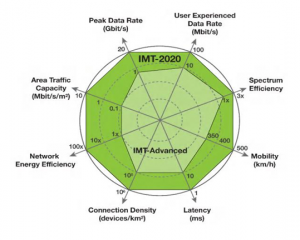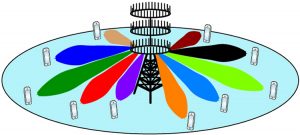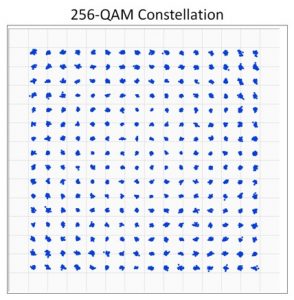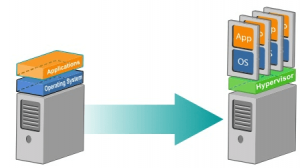- 5G Objectives
The target for 5G networks is to be highly efficient and fast and be able to support more users, devices, services, and new use cases without new costs or carbon footprint.
The below Figure illustrates anticipated performance gains, including 1000 times higher mobile data volume per area, 10 times to 100 times higher number of connected devices, 5 times reduced end-to-end latency, 10-100 times higher standard user data rate, and 10 times longer battery life in low power machine-to-machine communications (MMC).

- Technological Building Blocks to Achieve the Objectives
- Millimeter Wave Frequencies:
The use of millimeter wave frequencies constitutes one of the disruptive 5G technologies. The term refers to the frequencies above 6 GHz which have never been considered for mobile network roll-outs, for reasons of technological maturity and propagation quality.
To fulfill the needs for the increasing data rates and traffic volumes, new bands with very wide channels (over 100 MHz/per user) should be applied. Millimeter wave frequencies could give this spectrum resource, and in some situations, their use would make it possible to reach the data rates.
- Massive MIMO (Multiple Inputs – Multiple Outputs):
This technology includes the use of a large number of smart micro-antennae which are located on the same panel (between 8-128 today, but the number is expected to increase with the usage of frequencies above 6 GHz).
The need to use massive MIMO is twofold: 1st, the technology enables the increase of data rates, because of multiplexing; 2nd, it focuses energy on a device to enhance its link budget, because of beam-forming.
- Full Duplex:
In old systems, transmission and reception occur either on Frequency Division Duplexing (FDD) existing on all mobile network bands, or at different times: Time Division Duplexing (TDD).
The full duplex is intended to enable the simultaneous transmission and reception of data, on the same frequencies, at the same time and in the same location.
- NOMA Multiplexing (Non Orthogonal Multiple Access):
LTE uses what is referred to as orthogonal multiplexing, with each device using a portion of the resource blocks in a unique fashion at any given time. For 5G to provide improved spectrum efficiency compared to 4G, the plan is to use non-orthogonal multiplexing methods, whereby several users can use the same frequencies at the same time.
A distinction can be made between several users by assigning different codes to each user – referred to as SCMA or sparse code multiple access – a combination of 3G’s code division multiple access (CDMA) and 4G’s orthogonal frequency division multiple access (OFDMA) or by playing on the difference in users’ signal to noise ratios (NOMA). These are the two methods chosen for NR.
- QAM256:
As with many modern communication systems, 4G uses quadrature amplitude modulation (QAM). This modulation can achieve QAM64 in 4G. That is six bits of data are transmitted (2^6 = 64) at any given time. The main limitation on QAM order on wireless systems is the signal to noise ratio; that is when a huge amount of data is sent all at once, its transmission will be object to disruptions. For instance, if you are trying to talk in a noisy environment, it is easy to understand a simple “yes” or “no” but much harder to understand more complicated sentences.
5G modulation could reach QAM256 thanks to an improved link budget through antenna or signal processing technologies. For example, 8 bits of information transmitted at any given time, translates into a 33% increase in maximum capacity in ideal conditions. This improved modulation will also be deployed on advanced 4G systems.
- IoT Waveforms:
For the future deployment of 5G IoT in mobile bands, new waveforms are being explored. But although mass market IoT is one of the main challenges put forth for 5G, no concrete results have yet been made public.
Operators are starting to deploy new standards (EC-GSM or Extended Coverage GSM, LTE-(e)MTC or enhancements for Machine-Type Communications, NB-IoT or NarrowBand IoT) which were defined by 3GPP in Release 13 but, as they are based on 2G and 4G, they do not deliver the performance levels, notably in terms of autonomy, coverage, and density, that are compatible with the targets set for future 5G networks. -
Virtualization
Virtualization builds on concepts already seen in cloud computing, whereby the services and capabilities offered by a system are decoupled from the underlying infrastructure that delivers them.
Theoretically speaking, this could allow network operators to sell network capabilities, for example, capacity, coverage, and quality of service. It could also allow network operators to expand and improve the capabilities of their networks in a resilient way, by launching new or improved technologies within the existing framework.
-
Lighter Protocols
Achieving low latency (1ms) needs new techniques for the allocation of shared radio resources. The issue can be somehow solved by transmitting very high speed data bursts using a wide bandwidth in a short period of time.
However, there is also a need to take another look at the way shared resources are allocated to users and some organizations are investigating new approaches to Medium Access Control (MAC) protocols, to give more immediate access to resources better than old systems.
Given the essential importance of mobile communications, it will be important for 5G networks to arrive on time, to meet the expected requirements after 2020. This will be no small task, given the size of the challenge, the complexity of the solution and the diversity of current proposals.
